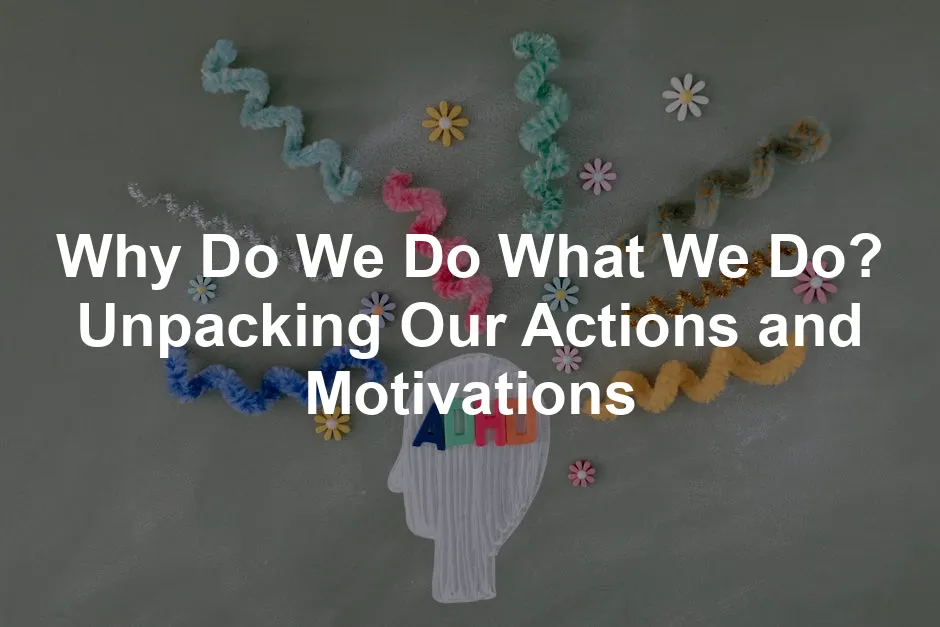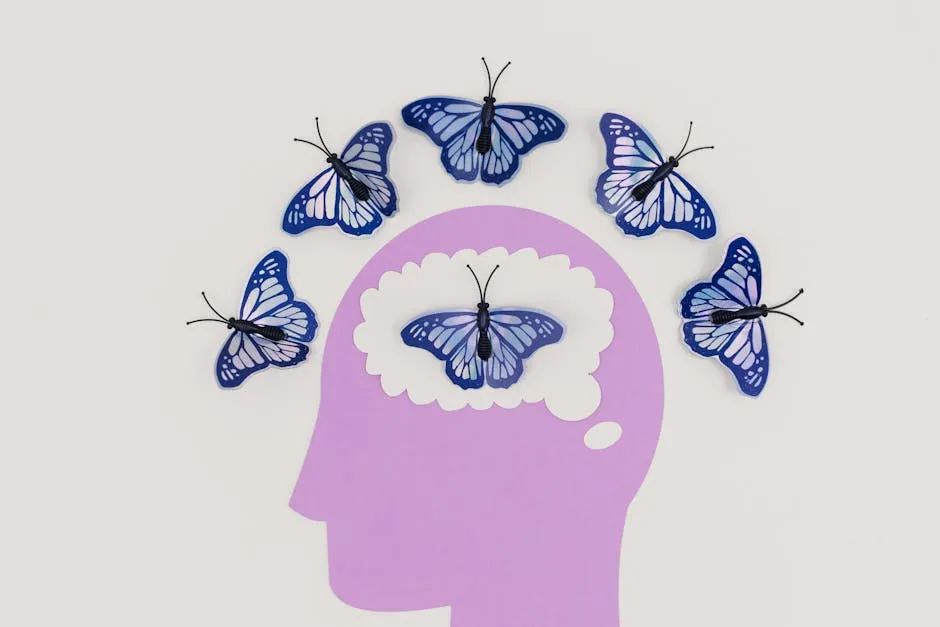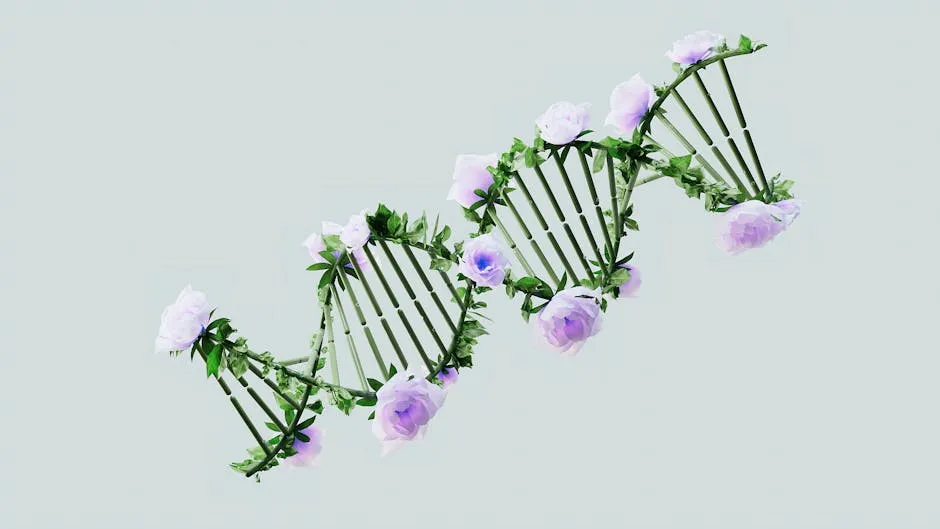
Why Do We Do What We Do? Unpacking Our Actions and Motivations
Introduction
In a world overflowing with choices and consequences, we often find ourselves pondering, “Why do we do what we do?” This question creeps into our minds as we navigate through daily habits, respond to stress, or even embrace those quirky traits that make us unique. Understanding the reasons behind our actions can be both enlightening and empowering.
Have you ever wondered why you reach for that extra slice of cake when you’re feeling down? Or why you can’t resist binge-watching that new series, even though you have a million things to do? Spoiler alert: the answers may surprise you!
This article takes a humorous yet insightful look into the psychological, social, and biological factors that influence our decisions and behaviors. We’ll explore how societal norms, peer pressure, and even our brain chemistry shape our actions. From the seemingly trivial to the deeply profound, the intricate web of motivations behind our behavior will spark your curiosity about human nature.
As we dive into this fascinating exploration, expect to unravel the mysteries behind what drives us. You might even find a few “aha!” moments that lead to some self-reflection. After all, understanding ourselves better can empower us to make more conscious choices. So, buckle up and prepare for a lighthearted yet thought-provoking ride into the depths of our motivations!

Summary Section
This article unpacks the complexities of human behavior by answering the question, “Why do we do what we do?” Here are some key points we’ll cover:
- Psychological Factors: We’ll look at how our thoughts and feelings, along with unconscious motivations, shape our actions, revealing the interesting layers of our minds.
- Social Influences: Let’s uncover how societal norms, peer pressure, and cultural expectations play a significant role in the choices we make, sometimes against our better judgment.
- Biological and Neurological Aspects: Discover how our brain chemistry and genetics influence our behavior, making some of our choices feel almost automatic.
- Coping Mechanisms: We’ll dive into the strategies we develop to handle stress, anxiety, and emotional pain. Spoiler: some of them are a bit quirky!
- The Role of Habit: Habits can dictate our actions without us even realizing it. Learn how to recognize and break free from those unhelpful patterns.
By the end of this article, you’ll gain a deeper understanding of the multifaceted factors driving human behavior. You’ll likely find yourself with more questions than answers, igniting a desire to learn more about yourself and the fascinating world of human behavior.

1. Psychological Factors
1.1 The Power of the Mind
Cognitive psychology plays a crucial role in understanding why we act the way we do. Our thoughts, beliefs, and perceptions shape our behaviors in profound ways. The mind is like a puzzle, where each piece represents a thought or belief. When these pieces fit together, they create our reality.
One prominent theory is Maslow’s hierarchy of needs. This pyramid illustrates the stages of human motivation, from basic needs like food and safety to higher-level needs such as belonging and self-actualization. Imagine trying to achieve your life goals while worrying about where your next meal will come from! This theory suggests that our actions are often driven by unmet needs. For instance, someone might work overtime to secure financial stability, allowing them to pursue their passion later. Speaking of motivation, a great visual reminder of this theory is a Maslow’s Hierarchy of Needs Poster. It’s like a motivational pep talk for your wall!
Our cognitive processes also influence decision-making. The way we interpret information can lead to biases. Have you ever caught yourself thinking, “I always mess things up”? That negative self-talk can significantly impact your choices. In contrast, a positive mindset can motivate you to take risks and pursue opportunities. Understanding these psychological factors helps us recognize how our thoughts can dictate our actions.

1.2 Unconscious Motivations
Unconscious motivations are like hidden drivers of our actions. Freudian concepts suggest that we are often unaware of the underlying reasons for our behavior. Take defense mechanisms, for example. These are psychological strategies that protect us from anxiety. For instance, if you avoid confronting a problem, you might be using denial. This can manifest in daily life when someone postpones a difficult conversation, only to feel more anxious later.
Another example is projection, where we attribute our feelings to others. Ever been annoyed at a friend for being late because you secretly feared you would be late too? Such unconscious motivations can lead to misunderstandings and conflict. Recognizing these patterns allows for more thoughtful, intentional behavior.
Moreover, unconscious desires can influence our choices and relationships. Have you ever found yourself drawn to someone you know is bad for you? These patterns often stem from unresolved issues from the past. By becoming aware of these motivations, we can work towards healthier relationships and better choices. And if you’re looking to enhance your emotional awareness, consider picking up a copy of Emotional Intelligence 2.0 by Travis Bradberry. It’s a game changer for understanding your feelings!

1.3 Emotional Influences
Emotions are powerful forces steering our actions. Ever made an impulsive decision in a fit of anger? Emotions can cloud judgment and lead to regrettable choices. Understanding this connection is essential for better decision-making.
Emotional intelligence (EI) plays a significant role here. Individuals with high EI can recognize and manage their emotions effectively. They understand the impact emotions have on their behavior and can navigate social situations more adeptly. For example, when faced with criticism, someone with high EI might respond calmly rather than defensively. This ability to process emotions leads to healthier interpersonal relationships and decision-making.
Furthermore, our emotions can motivate us toward action. Have you ever felt inspired after watching a motivational video? That surge of positivity can ignite a desire to pursue your goals. Conversely, feelings of sadness or anxiety might lead to withdrawal. Understanding these emotional influences allows us to harness our feelings for personal growth. If you want to delve deeper into this topic, check out The Power of Habit: Why We Do What We Do in Life and Business by Charles Duhigg. It’s the perfect guide to understanding how habits shape our lives!

2. Social Influences
2.1 Cultural Norms and Expectations
Culture profoundly shapes our perceptions and actions. From the music we enjoy to the values we hold dear, cultural norms guide our behavior. For instance, in collectivist societies, people prioritize group harmony over individualism. This can influence decisions, such as choosing a career that benefits the family rather than pursuing personal passions.
Cross-cultural differences highlight how these norms affect behavior. Consider how greetings vary around the world. In some cultures, a firm handshake is standard, while in others, a gentle bow is preferred. These variations illustrate how cultural expectations guide our interactions and choices.
Moreover, cultural upbringing can influence everything from our food preferences to our work ethics. Understanding these cultural influences helps us appreciate the diversity of human behavior. It also encourages empathy towards others, as we recognize that their actions stem from their cultural backgrounds. For those interested in fostering a more mindful approach to life, Mindfulness for Beginners by Jon Kabat-Zinn is a wonderful resource!

2.2 Peer Pressure
Peer pressure can significantly impact our choices, often leading us to conform to group norms. It’s a powerful force, especially among adolescents. Research shows that individuals are more likely to engage in risky behaviors when surrounded by friends. For instance, if your friends decide to skip class, you might feel compelled to join them, even if you know it’s not the best choice.
Studies indicate that the desire for social acceptance can lead to actions that go against personal values. This phenomenon isn’t limited to teens. Adults can feel similar pressures in professional settings. Have you ever felt nudged to participate in office gossip because everyone else was? Recognizing the impact of peer pressure allows us to make more conscious choices about who we surround ourselves with.
Additionally, breaking free from peer influence can be empowering. It encourages authenticity and individuality. Embracing your values despite external pressures fosters self-confidence and personal growth. If you’re looking for a bit of inspiration to stay true to yourself, consider reading The Subtle Art of Not Giving a F*ck by Mark Manson. It’s a refreshing take on self-acceptance!

2.3 Societal Expectations
Societal roles and norms play a significant part in shaping behavior. Gender roles, for instance, can dictate how individuals express themselves. In many societies, men are expected to be assertive, while women are often encouraged to be nurturing. These expectations can create pressure to conform, leading individuals to act in ways that don’t align with their true selves.
Social identity theory suggests that we derive a sense of self from our group memberships. This can lead to a “us vs. them” mentality, where individuals might act in ways that benefit their group while harming others. Understanding this can help us challenge biases and promote inclusivity.
Moreover, societal expectations can influence career choices. Many people feel compelled to pursue traditional professions due to family or cultural pressures. Recognizing these influences empowers individuals to pursue paths that align with their passions, rather than simply following the crowd. To help navigate these paths, consider checking out The Happiness Project by Gretchen Rubin. It offers insightful strategies for finding joy in your choices!

In summary, both psychological and social factors play a pivotal role in shaping our behavior. By understanding these influences, we can gain insights into our actions and make more conscious choices about how we live our lives.

3. Biological and Neurological Aspects
3.1 The Brain and Behavior
Our brains are incredible, aren’t they? They control everything we do, from how we feel to how we react to the world around us. The structure of the brain plays a pivotal role in shaping our behavior. Think of it as the command center, where different regions have specific functions. For example, the prefrontal cortex helps us make decisions, while the amygdala processes emotions like fear and pleasure.
When it comes to neurotransmitters, these little chemical messengers are vital. They transmit signals across the brain and influence our mood and motivation. Take serotonin, for example. This “feel-good” neurotransmitter is associated with happiness. Low levels can lead to feelings of sadness and anxiety. On the flip side, dopamine fuels our motivation and reward system. Ever felt that rush after completing a task? Thank dopamine for that little boost!
In short, our brain’s structure and neurotransmitter activity work together to dictate our behavior. It’s a fascinating dance of chemistry and biology that shapes who we are. If you’re interested in exploring how these elements relate to trauma and healing, consider reading The Body Keeps the Score: Brain, Mind, and Body in the Healing of Trauma by Bessel van der Kolk. It’s a profound read on the connection between mind and body!

3.2 Genetics and Behavior
The age-old debate of nature vs. nurture has intrigued scientists and philosophers alike. Genetics plays a crucial role in influencing behavior. Our DNA carries information that can predispose us to certain traits. For instance, have you ever noticed how some people seem naturally inclined toward extroversion or creativity? That might be in their genes!
But it’s not just about what we inherit; our environment also plays a significant role. Imagine two siblings raised in the same household. They might share similar genetic makeups but grow up with different personalities based on their individual experiences. For example, one might excel in sports while the other finds joy in art. This demonstrates how both genetics and environment shape our behaviors and interests.
Understanding these inherited traits helps us grasp why we act the way we do. The interplay of our genetic predispositions and life experiences creates a unique blend of characteristics that define us. If you’re interested in diving deeper into personal development, consider trying out a Personal Development Workbook. It can help you unlock your potential!

3.3 Hormonal Influences
Hormones are the body’s messengers, and they can significantly impact our moods and behaviors. During various life transitions—like puberty, pregnancy, or menopause—hormonal fluctuations can lead to emotional turbulence.
Take cortisol, often dubbed the “stress hormone.” When we face challenges, our body releases cortisol to help us cope. However, prolonged exposure can lead to anxiety and irritability. It’s like having a constant alarm ringing in your head!
On the other hand, oxytocin, the “love hormone,” plays a role in bonding and social connections. Ever felt a surge of warmth while hugging a friend? That’s oxytocin at work!
By understanding these hormonal influences, we can better navigate our emotional landscapes. Recognizing when hormones might be affecting our behavior allows us to respond more mindfully. And if you want to explore stress relief techniques, a Stress Relief Coloring Book can be a fun and therapeutic outlet!

4. Coping Mechanisms
4.1 Stress and Coping
Stress is inevitable, but how we cope with it makes all the difference. Coping mechanisms fall into two categories: adaptive and maladaptive. Adaptive strategies, like exercise or talking to a friend, promote well-being. Maladaptive strategies, such as binge-eating or excessive drinking, can lead to more harm than good.
For example, imagine a student facing exam stress. An adaptive response might be studying effectively and practicing mindfulness. A maladaptive response could involve procrastination and cramming at the last minute.
Understanding these coping strategies helps us choose healthier options. It’s all about finding what works best for us in stressful situations. And if you’re looking to incorporate mindfulness into your routine, I highly recommend picking up a Mindfulness Journal. It’s a great way to reflect and enhance your well-being!

4.2 The Role of Resilience
Resilience is like a mental muscle. It helps us bounce back from adversity. Those with high resilience tend to handle stress better and maintain a positive outlook.
Building resilience isn’t a one-size-fits-all approach. It involves developing a supportive network, practicing self-care, and fostering a growth mindset. Remember, setbacks are often setups for comebacks!
Incorporating small practices, like gratitude journaling or mindfulness, can enhance resilience. These strategies remind us of our strengths and help us navigate life’s challenges with grace. A Gratitude Journal can be a fantastic tool to help you focus on the positive aspects of life!
In conclusion, understanding the biological and neurological aspects of our behavior, along with effective coping mechanisms, provides us with valuable insights into why we do what we do. It empowers us to make informed choices and cultivate healthier habits, leading to a more fulfilling life.

5. The Role of Habit
5.1 Understanding Habits
Habits are the foundation of our daily actions. They shape our lives in ways we often overlook. The science of habit formation revolves around a simple structure known as the habit loop. This loop consists of three main components: cue, routine, and reward.
First, there’s the cue. This is a trigger that initiates the habit. It could be something as mundane as a time of day or even an emotional state. For example, when you feel stressed, your cue might prompt you to reach for a snack. Next comes the routine, which is the behavior itself. In our snack example, this is the act of munching away on chips or cookies. Finally, we have the reward, which reinforces the habit. This could be the pleasure derived from the taste or the temporary relief from stress.
Over time, these habits become automatic. You might not even think about reaching for that snack; it just happens! This automation is what makes habits both helpful and problematic. Good habits, like exercising regularly, contribute positively to our lives. Bad habits, like procrastinating, can derail our productivity. Understanding this loop helps us realize how deeply ingrained our behaviors can be. If you’re looking to establish better habits, consider reading Atomic Habits: An Easy & Proven Way to Build Good Habits & Break Bad Ones by James Clear. It’s a fantastic guide on habit formation!

5.2 Breaking Bad Habits
Now, breaking those pesky bad habits can feel like an uphill battle. But don’t worry! There are strategies to help you change undesirable behaviors. It all starts with self-awareness. Recognizing the cues that trigger your bad habits is essential. Are you reaching for that snack out of boredom? Identifying the cue is the first step toward change.
Mindfulness plays a critical role in this process. By practicing mindfulness, you can create a pause between the cue and your reaction. Instead of immediately acting on impulse, take a moment to reflect. Ask yourself, “Do I really want this?” This simple question can lead to better decision-making.
Another effective strategy is to replace the bad habit with a healthier alternative. If stress triggers your snack habit, consider going for a quick walk instead. It not only distracts you but also offers a healthier outlet for stress.
Additionally, accountability can be a game-changer. Share your goals with friends or family. They can offer support and encouragement as you work to change your habits. Remember, change takes time. Be patient with yourself and celebrate small victories along the way.
In summary, understanding the science behind our habits equips us with the tools to effect change. With self-awareness, mindfulness, and support, breaking bad habits becomes a more manageable journey. After all, habits shape our lives, but we have the power to reshape them!
Conclusion
As we wrap up this exploration of why we do what we do, it becomes clear that our actions are shaped by a multitude of factors. From the psychological motivations that drive us to the societal influences that nudge us along, the complexity of human behavior is fascinating. Understanding these elements empowers us to make more conscious choices and break free from unhelpful patterns.
The journey of self-discovery is ongoing. By constantly asking “why,” we open the door to greater awareness and understanding of ourselves. It’s like shining a flashlight into the dark corners of our minds. You might stumble upon some surprising insights!
Moreover, cultivating self-compassion is crucial. Recognizing that everyone grapples with their own habits and motivations fosters empathy. We’re all in this together, navigating the twists and turns of life. So, let’s embrace the journey, learn from our actions, and keep asking, “Why do I do that?” After all, the answers might just lead to personal growth and transformation.
FAQs
What are some common psychological factors that influence behavior?
Behavior is often swayed by various psychological factors. Cognitive biases, for instance, can distort our thinking. Ever heard of confirmation bias? It’s when we seek info that supports our existing beliefs, ignoring contrary evidence. This can lead to poor decision-making. Personality traits also come into play. Are you a perfectionist? You might avoid risks to maintain control. Emotional states can greatly influence our actions too. Feeling anxious? You might procrastinate. Recognizing these factors helps us understand why we act the way we do.
How does culture impact our actions?
Culture shapes our behavior in profound ways. Cultural norms dictate what’s considered acceptable or taboo. For example, in some cultures, individuality is celebrated, while in others, conformity is valued. This affects how we express ourselves and interact with others. Values passed down through generations also guide our choices. Collectivist societies often encourage cooperation, while individualistic cultures promote self-reliance. Understanding these cultural influences can enhance our empathy towards diverse perspectives and actions.
Can habits be changed?
Yes, habits can definitely be altered! Start by identifying the cues that trigger your habits. Are you snacking out of boredom? Next, replace bad habits with positive ones. Instead of reaching for chips, try a piece of fruit. Mindfulness helps too. By being present, you can pause before acting on impulse. Remember, it takes time to break a habit, so be patient with yourself. Celebrate small victories along the way, and don’t hesitate to seek support from friends or family.
What role does stress play in our behavior?
Stress significantly impacts our behavior and decision-making. When faced with stress, our bodies go into fight-or-flight mode. This can cloud judgment, leading to impulsive actions. For instance, under pressure, you might lash out at a coworker or make hasty decisions. Chronic stress can cause burnout, making it harder to cope with everyday challenges. Recognizing stress triggers and developing healthy coping strategies, like exercise or meditation, can help mitigate these effects.
Why is understanding our motivations important?
Understanding our motivations is key to personal growth. Self-awareness allows us to identify what drives our actions. This knowledge can help us make more informed choices and break free from unhelpful patterns. For instance, if you realize you often seek approval from others, you can work on building self-esteem. Additionally, understanding motivations fosters empathy. By recognizing our own motivations, we can better understand those of others, leading to improved relationships and communication.
Please let us know what you think about our content by leaving a comment down below!
Thank you for reading till here 🙂
All images from Pexels




